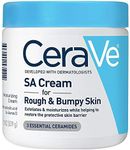Buying Guide for the Best Lotion For Keratosis Pilaris
Choosing a lotion for keratosis pilaris (KP) can make a big difference in how your skin looks and feels. KP is a common skin condition that causes small, rough bumps, often on the arms, thighs, or cheeks. The right lotion can help smooth these bumps and reduce redness. When shopping, it's important to look at the ingredients and features of the lotion, as not all moisturizers are equally effective for KP. Understanding what each key specification means will help you pick a product that matches your skin's needs and your personal preferences.Exfoliating IngredientsExfoliating ingredients are substances in the lotion that help remove dead skin cells from the surface, which is important for treating the rough texture of keratosis pilaris. Common exfoliants include alpha hydroxy acids (like lactic acid or glycolic acid) and beta hydroxy acids (like salicylic acid). Lotions with lower concentrations of these acids are gentler and suitable for sensitive skin or beginners, while higher concentrations offer stronger exfoliation for more stubborn bumps. If your skin is sensitive or you are new to exfoliating products, start with a lower concentration and see how your skin reacts before moving to stronger formulas.
Moisturizing IngredientsMoisturizing ingredients help keep your skin hydrated and soft, which is essential for managing KP. Look for lotions with humectants (like glycerin or hyaluronic acid) that draw moisture into the skin, and emollients (like shea butter or ceramides) that help lock it in. Lighter moisturizers are good for oily or combination skin, while richer, creamier formulas are better for very dry or rough skin. Choose a lotion based on how dry your skin feels and how much moisture you need throughout the day.
Fragrance-Free or ScentedSome lotions contain added fragrances, while others are fragrance-free. Fragrance-free lotions are less likely to irritate sensitive or already inflamed skin, which is common with KP. Scented lotions may be more enjoyable to use for some people, but they can sometimes cause irritation or allergic reactions. If you have sensitive skin or have reacted to scented products before, it's safer to choose a fragrance-free option.
Texture and AbsorptionThe texture of a lotion refers to how thick or light it feels, and how quickly it absorbs into the skin. Thicker lotions or creams provide a heavier barrier and are best for very dry or rough skin, while lighter lotions absorb quickly and feel less greasy, making them suitable for daytime use or for people who dislike heavy products. Think about when and where you plan to use the lotion—if you want something for daily use under clothes, a lighter, fast-absorbing formula may be best.
Non-ComedogenicNon-comedogenic means the lotion is formulated not to clog pores, which is important if you are prone to breakouts or have KP on areas like the face. If you have acne-prone skin or want to avoid any risk of clogged pores, look for lotions labeled as non-comedogenic. For those who do not have issues with breakouts, this may be less of a concern.














